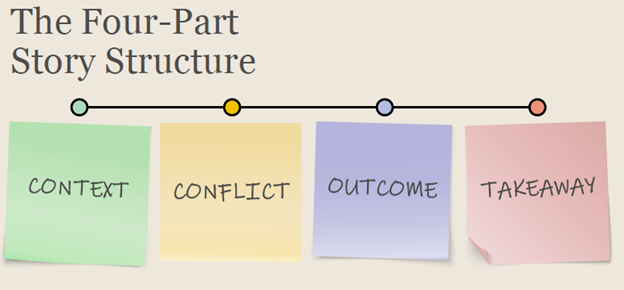
Table of Contents
Humans aren’t emotionally engaged by facts and data. Yet most leaders try to use these to influence their people. Then they wonder why their messages fall flat. A better approach is to unleash the power of storytelling.
In this article we show how to use the mechanics of story to inspire and motivate your employees more effectively.
At the Business Execution Summit (BEx) 2023, Karen Eber took us on a journey of storytelling. She equipped us with insights and tools to better plan and deliver our messages as leaders.
A past guest on Unleashed, Karen works with Fortune 500 companies and lectures in Universities like Emory and Purdue. Her passion is showing people how to unlock the power of story.
Why Stories Work
Throughout human history, people have been engaged by story. From our earliest evolution, mankind has gathered and shared tales of tradition, adversity, and resolution. These stories recounted the past and become the underpinnings of the culture.
Today, storytelling is big business. Globally, the entertainment and media industry is over two-trillion dollars and growing. Increasingly, people are spending more of their discretionary funds to enjoy stories.
Karen breaks down the brain science behind our attraction to stories. Our brains have “factory settings” that naturally incline us to story. Our brains:
- Are lazy and seek what is familiar.
- Predict and make assumptions.
- Categorize information into our mental library of files.
- Want safety and belonging, and therefore they’re always scanning for our “in groups” and avoiding our “out groups.”
- Seek pleasure and avoids pain.
All good stories follow a pattern that ties to these factory settings. For example, characters we love in stories are those we can relate to in some way, thus they feel part of our “in group.” Stories follow a four-part structure which helps our brains easily know were we are in the script, and where we will go next. And we love predicting what will happen, and then feeling validated if we are right and surprised if we are wrong.
“Data doesn’t change behavior, emotions do”
- Karen Eber
Stories do something else too; they engage our emotions. We feel the excitement, fear, or anger of characters as if they were our own. This more deeply roots stories into our minds and influences future behavior. Think about how vividly you can recall specifics of stories you’ve seen or read.
Communicating as a Leader
Informed leaders build their stories around the classic 4-part structure: Context, Conflict, Outcome and Takeaway.

To demonstrate how this works, let’s consider the extremely popular Back to the Future script:
- Context – Marty McFly is a regular kid with what seems to be no useful skills. His family members each have their shortcomings, and they are embarrassing to him. Marty has a wacky mad-scientist friend, Doctor Emmett Brown.
- Conflict – In a frantic action scene, Doc is shot, and Marty ends up in a time machine taking him back to the ‘50s where he interrupts his parent’s courtship. This weakens the timeline and causes Marty’s very existence to start to fade from reality.
- Outcome – Through quick action and resourcefulness, Marty reconnects his family’s timeline and travels back to his own time in the 1980s.
- Takeaway – Marty sees how his actions in the past have improved the life of his family members in the present. He comes away with greater understanding and fondness for the people around him.
Pick any of your favorite movies or books and you’ll see this same pattern.
Deep Engagement
Great stories engage people with detail and sensory information. The smell of spring lilacs, the feel of fine-grit sandpaper, and the clash of cymbals, deeply connect us to situations.
Greater detail is important too. Choosing specific descriptors takes people more fully into our messages:
|
Good |
Better |
|
we had dessert |
we had butter pecan ice cream with caramel |
|
my phone my phone blew up with messages |
I came back to 17 text messages |
|
it was a small scar |
the scar was the size of a pencil |
|
he trusted her |
he gave her the passcode to his phone |
Unleashing the Potential of Your Organization
Leaders who understand how to communicate with story inspire, engage, and motivate their teams. They are always on the lookout for story ideas and weave these into messages to reinforce the culture and advance the vision.
“Don’t wait for the perfect story. Make your stories perfect”
- Karen Eber
If you’d like to learn more about leadership communication, or other ways you can take the simpler path to creating a great business, connect with us or consider attending one of our upcoming leadership events.



